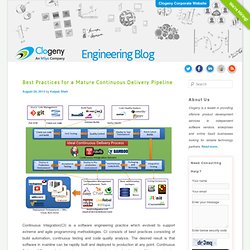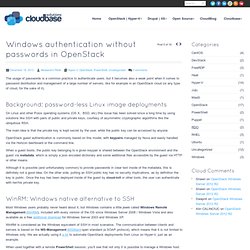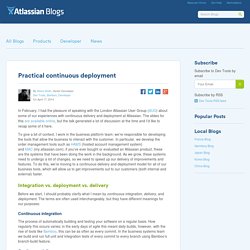

Building DevOps Toolchain. Building DevOps Toolchain. Clogeny. Continuous Integration(CI) is a software engineering practice which evolved to support extreme and agile programming methodologies.

CI consists of best practices consisting of build automation, continuous testing and code quality analysis. The desired result is that software in mainline can be rapidly built and deployed to production at any point. Continuous Delivery(CD) goes further and automates the deployment of software in QA, pre-production and production environments. Continuous Delivery enables organizations to make predictable releases reducing risk and, automation across the pipeline enables reduction of release cycles. CD is no longer an option if you run geographically distributed agile teams. Clogeny has designed and deployed continuous integration and delivery pipelines for start-ups and large organizations leading to benefits like: A mature continuous delivery pipeline consists of the following steps and principles: Techtrends-xebia-devops.
Discussion on using Rerun to automate DevOps toolchains. Agnostic Continuous Delivery. Rundeck Community Hangout (July 11, 2013) Installation — Pyjnius 1.0a1 documentation. Windows authentication without passwords with WinRM and OpenStack. The usage of passwords is a common practice to authenticate users, but it becomes also a weak point when it comes to password distribution and management of a large number of servers, like for example in an OpenStack cloud (or any type of cloud, for the sake of it).

Background: password-less Linux image deployments On Linux and other Posix operating systems (OS X, BSD, etc) this issue has been solved since a long time by using solutions like SSH with pairs of public and private keys, courtesy of asymmetric cryptographic algorithms like the ubiquitous RSA. The main idea is that the private key is kept secret by the user, while the public key can be accessed by anyone. OpenStack guest authentication is commonly based on this model, with keypairs managed by Nova and easily handled via the Horizon dashboard or the command line. Although it is possible (and unfortunately common) to provide passwords in clear text inside of the metadata, this is definitely not a good idea. WinRM HTTPS Listener . . Practical continuous deployment. In February, I had the pleasure of speaking with the London Atlassian User Group (AUG) about some of our experiences with continuous delivery and deployment at Atlassian.

The slides for this are available online, but the talk generated a lot of discussion at the time and I’d like to recap some of it here. To give a bit of context, I work in the business platform team; we’re responsible for developing the tools that allow the business to interact with the customer. In particular, we develop the order management tools such as HAMS (hosted account management system) and MAC (my.atlassian.com); if you’ve ever bought or evaluated an Atlassian product, these are the systems that have been doing the work in the background. As we grow, these systems need to undergo a lot of changes, so we need to speed up our delivery of improvements and features. Integration vs. deployment vs. delivery Before we start, I should probably clarify what I mean by continuous integration, delivery, and deployment.
Practical continuous deployment. Rackspace Aiding the Introduction of DevOps by Extending Their Managed Cloud Service Levels. Rackspace, cloud computing platform provider and founder of OpenStack, is currently introducing its new DevOps Automation Service.

They offer managed support for things like infrastructure and workflow automation, monitoring and log aggregation, and source control for infrastructure code. Rackspace has identified the shortage of DevOps engineers as a major problem in the industry. Based on the technology and processes they use in-house, they’ve crafted the new service to help their customers to speed up their development and IT. When a client signs up to their DevOps Automation Service, Rackspace works with the client to understand the client’s existing infrastructure. Then Rackspace can take over the development of Chef cookbooks and help the client to setup and operate the tools typically needed to grow a DevOps culture at the client organization.
Rundeck Community Hangout (October 9, 2013) Rundeck Community Hangout (July 11, 2013) Agnostic Continuous Delivery. RunDeck. RunDeck.